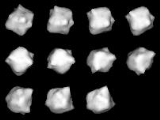
3908 Nyx
Encyclopedia
3908 Nyx is an Amor
and Mars-crosser asteroid
. It was discovered by Hans-Emil Schuster
on August 6, 1980, and is named after Nyx, the Greek
goddess of the night, after which Pluto
's moon
Nix
is also named. It is 1–2 km in diameter and is a V-type asteroid
, meaning that it may be a fragment of the asteroid 4 Vesta
.
In 2000, radar observations conducted at the Arecibo and Goldstone
observatories produced a model of Nyx's shape; the asteroid can best be described as spherical but with many protruding lumps.
To avoid confusion with 3908 Nyx, Pluto
's moon Nix
was changed from the initial proposal of the classical spelling Nyx, to Nix.
Amor asteroid
The Amor asteroids are a group of near-Earth asteroids named after the asteroid 1221 Amor. They approach the orbit of the Earth from beyond, but do not cross it. Most Amors do cross the orbit of Mars...
and Mars-crosser asteroid
Mars-crosser asteroid
A Mars-crosser is an asteroid whose orbit crosses that of Mars. The known numbered Mars-crossers are listed here. They include the two numbered Mars trojans 5261 Eureka and ....
. It was discovered by Hans-Emil Schuster
Hans-Emil Schuster
Hans-Emil Schuster is a German astronomer who retired in October 1991. He worked at Hamburg Observatory at Bergedorf and European Southern Observatory , and was former acting director of La Silla Observatory...
on August 6, 1980, and is named after Nyx, the Greek
Greek mythology
Greek mythology is the body of myths and legends belonging to the ancient Greeks, concerning their gods and heroes, the nature of the world, and the origins and significance of their own cult and ritual practices. They were a part of religion in ancient Greece...
goddess of the night, after which Pluto
Pluto
Pluto, formal designation 134340 Pluto, is the second-most-massive known dwarf planet in the Solar System and the tenth-most-massive body observed directly orbiting the Sun...
's moon
Natural satellite
A natural satellite or moon is a celestial body that orbits a planet or smaller body, which is called its primary. The two terms are used synonymously for non-artificial satellites of planets, of dwarf planets, and of minor planets....
Nix
Nix (moon)
Nix is a natural satellite of Pluto. It was discovered along with Hydra in June 2005, and is to be visited along with Pluto by the New Horizons mission in July 2015.- Discovery :...
is also named. It is 1–2 km in diameter and is a V-type asteroid
V-type asteroid
The spectra of the V-type asteroids or Vestoids are similar to that of 4 Vesta, by far the largest asteroid in this class ....
, meaning that it may be a fragment of the asteroid 4 Vesta
4 Vesta
Vesta, formally designated 4 Vesta, is one of the largest asteroids, with a mean diameter of about . It was discovered by Heinrich Wilhelm Olbers on March 29, 1807, and is named after the Roman virgin goddess of home and hearth, Vesta....
.
In 2000, radar observations conducted at the Arecibo and Goldstone
Goldstone Deep Space Communications Complex
The Goldstone Deep Space Communications Complex — commonly called the Goldstone Observatory — is located in California's Mojave Desert. Operated by ITT Corporation for the Jet Propulsion Laboratory, its main purpose is to track and communicate with space missions. It includes the Pioneer...
observatories produced a model of Nyx's shape; the asteroid can best be described as spherical but with many protruding lumps.
To avoid confusion with 3908 Nyx, Pluto
Pluto
Pluto, formal designation 134340 Pluto, is the second-most-massive known dwarf planet in the Solar System and the tenth-most-massive body observed directly orbiting the Sun...
's moon Nix
Nix (moon)
Nix is a natural satellite of Pluto. It was discovered along with Hydra in June 2005, and is to be visited along with Pluto by the New Horizons mission in July 2015.- Discovery :...
was changed from the initial proposal of the classical spelling Nyx, to Nix.
See also
- V-type asteroidV-type asteroidThe spectra of the V-type asteroids or Vestoids are similar to that of 4 Vesta, by far the largest asteroid in this class ....
- HED meteoriteHED meteoriteHED meteorites are a subgroup of achondrite meteorites. HED stands for "Howardite–Eucrite–Diogenite".These achondrites came from a differentiated parent body and experienced extensive igneous processing not much different from the magmatic rocks found on Earth and for this reason they closely...
- 4 Vesta4 VestaVesta, formally designated 4 Vesta, is one of the largest asteroids, with a mean diameter of about . It was discovered by Heinrich Wilhelm Olbers on March 29, 1807, and is named after the Roman virgin goddess of home and hearth, Vesta....
- 4055 Magellan4055 Magellan4055 Magellan is an Amor asteroid discovered on February 24, 1985, by E. Helin at Palomar.-See also:* V-type asteroid* HED meteorite* 4 Vesta* 3908 Nyx* 3551 Verenia- External links :*...
- 3551 Verenia3551 Verenia3551 Verenia is an Amor asteroid and a Mars crosser discovered in 1983 by R. Scott Dunbar. Although Verenia passed within 40 Gm of the Earth in the 20th century, it will never do so in the 21st...

